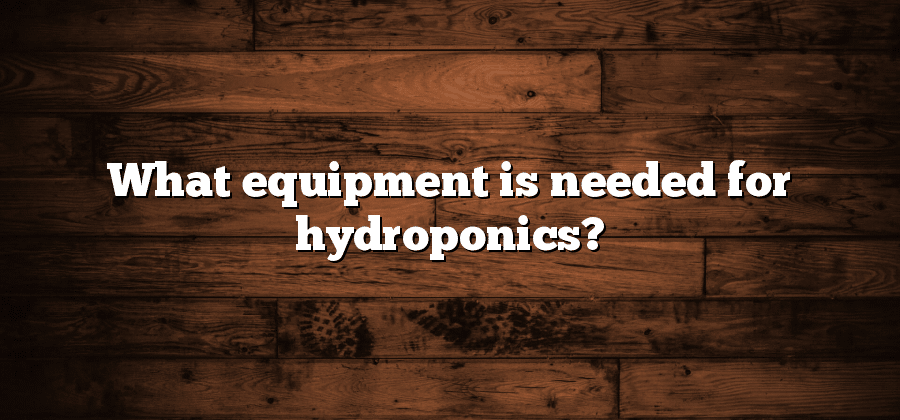Growing Mediums: Selecting the Ideal Substrate
When it comes to hydroponic gardening, selecting the ideal substrate is crucial for the success of your plants. The growing medium you choose will provide the necessary support and nourishment for the roots, ensuring optimal growth and development. There are several options available, each with its own unique characteristics and benefits.
One popular choice for hydroponic systems is rockwool, a mineral-based substrate that retains moisture while allowing for excellent aeration. Its fibrous structure promotes root growth and helps to prevent waterlogging. Another commonly used substrate is coconut coir, which is made from the fibrous husks of coconuts. It has excellent water retention capabilities and provides a balanced mix of air and water for the roots. Other options include perlite, vermiculite, and expanded clay pellets, each with their own advantages depending on the specific needs of your plants. It is important to consider factors such as water retention, aeration, pH levels, and nutrient retention when selecting the ideal substrate for your hydroponic garden.
Nutrient Solution: Balancing Plant Nutrition
A crucial aspect of successful hydroponic gardening is balancing the nutrient solution to provide plants with optimal nutrition. The nutrient solution serves as the primary source of essential nutrients for plants, replacing the need for traditional soil. Balancing the nutrient solution involves ensuring that plants receive the right amount and ratio of nutrients, promoting healthy growth and development.
When it comes to nutrient solution formulation, precision is key. Each plant has specific nutrient requirements, and these needs can vary throughout different stages of growth. It is essential to understand the nutrient deficiencies and excesses that can occur and adjust the solution accordingly. By monitoring the pH levels and regularly testing the nutrient solution, growers can fine-tune the composition to maintain the correct balance of macronutrients, micronutrients, and essential minerals. A well-balanced nutrient solution enhances the overall health and vigor of plants, leading to higher yields and quality produce in hydroponic systems.
Reservoirs: Maintaining a Steady Water Supply
Water is a crucial component for successful hydroponic systems, and maintaining a consistent water supply is essential. Reservoirs play a significant role in ensuring a steady supply of water to the plants throughout their growth cycle. These containers, typically made of durable materials such as plastic or stainless steel, are designed to hold a large volume of water.
To maintain a steady water supply, it is important to regularly monitor and replenish the reservoir. Checking the water level daily is recommended, and topping up as needed to avoid any water shortages. It is also important to maintain the quality of the water by periodically testing for pH levels and adjusting as necessary. Additionally, ensuring the reservoir is properly sealed can help prevent evaporation and contamination, prolonging the water’s usability. By implementing these measures, hydroponic growers can sustain a reliable water supply for their plants’ hydration needs.
Pumps and Aerators: Ensuring Proper Oxygenation
Proper oxygenation is crucial for the success of any hydroponic system. Pumps and aerators play a vital role in ensuring that plants receive a sufficient supply of oxygen for their growth and development. These devices help in maintaining the appropriate oxygen levels in the nutrient solution, thereby promoting healthy root growth and improving overall plant health.
When selecting a pump for your hydroponic system, it is important to consider the specific requirements of your setup. Different pumps have varying capacities and power capabilities, so it is crucial to choose one that can meet the demands of your system. It is recommended to opt for a pump that is reliable and durable, as it will be continuously running to ensure proper oxygenation. Additionally, consider the noise level of the pump, as excessive noise can be disruptive in certain indoor hydroponic environments.
Aerators, on the other hand, are used to introduce air into the nutrient solution to enhance oxygen levels. They work by creating small bubbles that rise to the surface, increasing the surface area of the solution in contact with the air. This promotes the transfer of oxygen into the solution and improves circulation, preventing stagnant water and reducing the potential for harmful microbial growth. When choosing an aerator, look for one that is efficient and easy to clean, ensuring that it does not become clogged over time.
In summary, pumps and aerators are essential components of a hydroponic system for maintaining proper oxygenation. It is vital to select reliable and durable pumps that meet the requirements of your system. Similarly, choosing efficient and easy-to-clean aerators will help promote healthy oxygen levels in the nutrient solution. By prioritizing oxygenation, you can create an optimal growing environment for your hydroponic plants.
Grow Lights: Providing Optimal Light Spectrum
Grow lights play a crucial role in indoor gardening. They provide an artificial light source that mimics the sun’s spectrum, allowing plants to undergo photosynthesis and grow effectively. When selecting grow lights for your indoor garden, it is essential to consider the optimal light spectrum required for different growth stages of plants.
Plants have varying light requirements during different stages of their growth cycle. In the vegetative stage, plants generally require blue light, which promotes leaf development and overall growth. On the other hand, during the flowering stage, plants need red light, as it stimulates flower and fruit production. By providing the appropriate light spectrum at each stage, you can ensure that your plants receive the ideal condition for optimal growth and yield.






